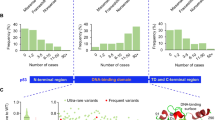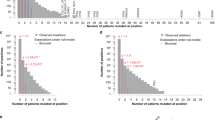Abstract
The p53 gene contains homozygous mutations in ~50–60% of human cancers. About 90% of these mutations encode missense mutant proteins that span ~190 different codons localized in the DNA-binding domain of the gene and protein. These mutations produce a protein with a reduced capacity to bind to a specific DNA sequence that regulates the p53 transcriptional pathway. Eight of these mutations are localized in codons that account for ~28% of the total p53 mutations and these alleles appear to be selected for preferentially in human cancers of many tissue types. This article explores the question 'Why are there hotspot mutations in the p53 gene in human cancers?' Four possible reasons for this are considered; (1) the hotspot mutant alleles produce a protein that has a highly altered structure, (2) environmental mutagens produce allele-specific changes in the p53 gene, (3) these mutations arise at selected sites in the gene due to a specific DNA sequence, such as a methylated cytosine residue in a CpG dinucleotide, which has a higher mutation rate changing C to T nucleotides, (4) along with the observed change in mutant p53 proteins, which produce a loss of function (DNA binding and transcription), some mutant proteins have an allele-specific gain of function that promotes cancer. Evidence is presented that demonstrates the first three possibilities all contribute some property to this list of hotspot mutations. The fourth possibility remains to be tested.
Similar content being viewed by others
Log in or create a free account to read this content
Gain free access to this article, as well as selected content from this journal and more on nature.com
or
References
Hainaut P, Pfeifer G . Somatic TP53 Mutations in the Era of Genome Sequencing. In: Lozanzo G, Levine AJ (eds). The p53 Protein, From Cell Regulation to Cancer.1st edn, Cold Spring Harbor Laboratory Press: Cold Spring Harbor, NY, USA, 2016 pp 279–300.
Bouaoun L, Sonkin D, Ardin M, Hollstein M, Brynes G, Zaudail J et al. TP53 variations in human cancers: new lessons from the IARC database and genomics. Hum Mutat 2016; 37: 865–876.
Lee J-K, Wang J, Sa JK, Ladewig E, Lee H-O, Lee I-H et al. Spatiotemporal genomic architecture informs precision oncology in glioblastoma. Nat Genet 2017; 49: 594–599.
Joerger AC, Fersht AR. The tumor suppressor p53: from structures to drug discovery. In: Levine AJ, Lane DP (eds). The p53 Family. 1st edn, Cold Spring Harbor Laboratory Press: Cold Spring Harbor, NY, USA, 2016 pp 19–38.
Campomenosi P, Monti P, Aprile A, Abbondandolo A, Frebourg T, Gold B et al. P53 mutants can often transactivate promoters containing a p21 but not Bax or PIG3 responsive elements. Onocgene 2001; 20: 3573–3579.
Leaver-Fay A, Tyka M, Lewis SM, Lange OF, Thompson J, Jacak R et al. ROSETTA3: an object-oriented software suite for the simulation and design of macromolecules. Methods Enzymol 2011; 487: 548–574.
Moult J, Fidelis K, Kryshtafovych A, Schwede T, Tramontano A . Critical assessment of methods of protein structure predictions (CASP) -round x. Proteins 2014; 82: 1–6.
Baugh E, Simmons-Edler R, Muller CL, Alford RF, Volfovsky N, Lash AE et al. Robust classification of protein variation using structural modelling and large-scale data integration. Nucleic Acids Res 2016; 44: 2501–2513.
Yu X, Vazquez A, Levine A, Carpizo DR . Allele-specific p53 mutant reactivation. Cancer Cell 2012; 21: 614–625.
Blanden AR, Yu X, Loh SN, Levine AJ, Carpizo DR . Reactivating mutant p53 using small molecules as zinc metallochaperones: awakening a sleeping giant in cancer. Drug Discov Today 2015; 20: 1391–1397.
Bressac B, Kew M, Wands J, Ozturk M . Selective G to T mutations of p53 gene in hepatocellular carcinoma from southern Africa. Nature 1991; 350: 429–432.
Denissenko M, Pao A, Tang M, Pfeifer G . Preferential formations of Benzo[a]pyrene adducts at lung cancer mutational hot spots in p53. Science 1996; 274: 430–432.
Hollstein M, Moiyra M, Grollman AP, Oliviera M . 2013, Analysis of TP53 mutation spectra reveals the fingerprint of the potent environmental carcinogen, aristolochic acid. Mutat Res 2013; 753: 41–49.
Dittmer D, Pati S, Zambetti G, Chu S, Teresky AK, Moore M et al. P53 gain of function mutations. Nat Genet 1993; 4: 42–46.
Harvey D, Levine AJ . p53 alteration is a common event in the spontaneous immortalization of primary Balb/c murine embryo fibroblasts. Genes Dev 1991; 5: 2375–2385.
Muller P, Vousden KH . P53 mutations in cancer. Nat Cell Biol 2012; 15: 2–8.
Lozano G, Levine A ( eds). The p53 protein from cell regulation to cancer. In: A subject collection from Cold Spring Harbor Perspectives in Medicine. CSHL Press: NY, 2016.
Hanel W, Marchenko N, Xu S, Weng W, Moll U . Two hot spot mutant p53 models display differential gain of function in tumorigenesis. Cell Death Differ 2013; 20: 898–909.
Alexandrova E, Mirza S, Xu S, Schulz-Heddergott R, Marchenko N, Moll U . p53 loss of heterozygosity is a necessary prerequisite for mutant p53 stabilization and gain of function in vivo. Cell Death Dis 2017; 8: e2661.
Alexandrova E, Yallowitz A, Li D, Xu S, Schulz R, Proia D et al. Improving Survival by exploiting tumor dependence on stabilized mutant p53 for treatment 2015 Nature 523: 352–356.
Baker SJ, Fearon ER, Nigro JM, Hamilton SR, Preisinger AC, Jessup JM et al. Chromosome 17 deletions and p53 gene mutations in colorectal carcinomas. Science 1989; 244: 217–221.
Ashkenazy H, Abadi S, Martz E, Chay O, Mayrose I, Pupko T et al. ConSurf 2016: an improved methodology to estimate and visualize evolutionary conservation in macromolecules. Nucleic Acids Res 2016; 44: W344–W350.
Acknowledgements
This work was partly supported by NIH grant Award 2P01CA087497-16A1.
Author information
Authors and Affiliations
Corresponding author
Ethics declarations
Competing interests
The authors declare no conflict of interest.
Additional information
Edited by F Pentimalli
Rights and permissions
About this article
Cite this article
Baugh, E., Ke, H., Levine, A. et al. Why are there hotspot mutations in the TP53 gene in human cancers?. Cell Death Differ 25, 154–160 (2018). https://doi.org/10.1038/cdd.2017.180
Received:
Revised:
Accepted:
Published:
Issue date:
DOI: https://doi.org/10.1038/cdd.2017.180
This article is cited by
-
Etoposide-induced protein 2.4 homolog promotes argininosuccinate synthase 1 and cancer cell survival upon arginine deprivation
Cellular & Molecular Biology Letters (2025)
-
Lipogenic enzyme FASN promotes mutant p53 accumulation and gain-of-function through palmitoylation
Nature Communications (2025)
-
Genomic hallmarks of endocrine therapy resistance in ER/PR+HER2- breast tumours
Communications Biology (2025)
-
Deciphering the safeguarding role of cysteine residues in p53 against H2O2-induced oxidation using high-resolution native mass spectrometry
Communications Chemistry (2025)
-
Natural compound PEITC inhibits gain of function of p53 mutants in cancer cells by switching YAP-binding partners between p53 and p73
Acta Pharmacologica Sinica (2025)



